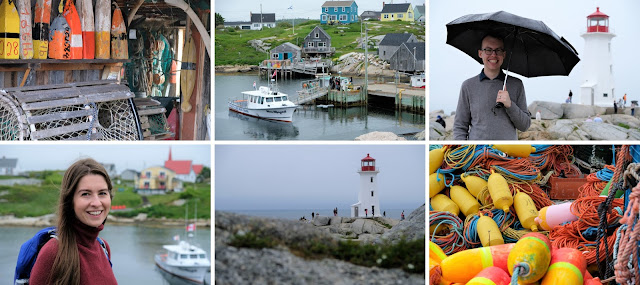Halifax
“Is that
lobster for carry-on, sir?” We knew we’d made it to the right airport when we
saw the live lobster. Founded in 1749 by Edward Cornwallis, Halifax is the
capital of Nova Scotia; home to St. Paul’s, the first Anglican cathedral
outside the UK; and known for the Halifax Explosion in December 1917, when a
munitions ship crashed in Halifax Harbour and caused the world’s largest
man-made blast before the atomic bomb. But mainly its reputation is a bustling
maritime hub, so having yearned for a more temperate climate and an Atlantic
breeze, there we were for a typically soggy Canada Day weekend.
Unsurprisingly, Halifax’s strongest military connections are with the Navy: it saw hundreds of thousands of Canadian soldiers board ships headed for Europe in the two World Wars, and it still hosts the eastern Canadian fleet. In the middle of the harbour, McNabs Island was transformed into a fort by the Victorians, but is now a charming camping spot. It turns out only tourists visit the island in the rain – and rather dogged British ones at that – so after we convinced our boat driver that we really did want to go, we wandered past abandoned turrets and along beautiful beaches with only seals and the occasional eagle for company.
We spent lots of time strolling along the waterfront, with its stalls, restaurants, and even (for one weekend only) RibFest – though, as the name suggests, it wasn’t the most vegetarian-friendly event. At the farmers’ market, I sampled the traditional Halifax delicacy, a lobster roll – and can report that it’s just as creamy and delicious as you would expect. We also enjoyed our trip to Steve-O-Reno’s Cappuccino (surely the best named café in all Canada), the Wooden Monkey (as a belated birthday treat), and Italian-inspired The Bicycle Thief right by the water.
Halifax has
a long military history – just the fact that it was founded at all started a
war with the Acadians (French settlers) and the Indigenous Mi’kmaq – and Canada
Day itself was marked with a 21-gun salute from the Citadel in the centre of
the old town. There was also a parade through the streets from the Royal Nova
Scotia International Tattoo – an extraordinary array of soldiers and dancers
featuring the Japan
Maritime Self-Defense Force Band, an acrobatics troupe from Chicago, and
bagpipers as far as the eye could see. (The sound was… impressive.)
Unsurprisingly, Halifax’s strongest military connections are with the Navy: it saw hundreds of thousands of Canadian soldiers board ships headed for Europe in the two World Wars, and it still hosts the eastern Canadian fleet. In the middle of the harbour, McNabs Island was transformed into a fort by the Victorians, but is now a charming camping spot. It turns out only tourists visit the island in the rain – and rather dogged British ones at that – so after we convinced our boat driver that we really did want to go, we wandered past abandoned turrets and along beautiful beaches with only seals and the occasional eagle for company.
The main Anglophone
port in the east, Halifax was for many years the first stop for anyone arriving
in Canada by boat. Between 1928 and 1971 over one million immigrants passed
through the doors of Pier 21, which today is a delightful museum. As we walked
through the original processing hall, it was humbling to think of those who
made much longer journeys than we did to call Canada their home.
We spent lots of time strolling along the waterfront, with its stalls, restaurants, and even (for one weekend only) RibFest – though, as the name suggests, it wasn’t the most vegetarian-friendly event. At the farmers’ market, I sampled the traditional Halifax delicacy, a lobster roll – and can report that it’s just as creamy and delicious as you would expect. We also enjoyed our trip to Steve-O-Reno’s Cappuccino (surely the best named café in all Canada), the Wooden Monkey (as a belated birthday treat), and Italian-inspired The Bicycle Thief right by the water.
One of
Halifax’s most prolific exports is beer – specifically Alexander Keith’s IPA
which has been brewed there since 1817. Mr Keith himself learnt his craft in
Edinburgh and Sunderland, before enjoying such success in Halifax that he was
elected mayor of the city three times. Our tour of the brewery (at Harriet’s
insistence, of course) featured a bottle from the 1800s and a Nova Scotian
ceilidh! Alas, the singing was far more enjoyable than the beer. (It’s no
London Pride.)
Even after
all that, our Canadian colleagues were adamant that a trip to Halifax is incomplete
without a trip to Peggy’s Cove. Just under an hour’s drive from Halifax we
found this tiny fishing village – named (so the legend says) after the sole
survivor of a nearby shipwreck – with its hard rock, small shops, and
picturesque lighthouse. In many ways it’s probably little different from the
other villages dotted along the Atlantic coast, yet its combination of charm
and industry vividly told the history of Nova Scotian life.
It’s become
a cliché of this blog that our Canadian experiences evoke our memories of the
UK. With the drizzle, seafood, and seemingly omnipresent bagpipes, this was no
different. On the one hand, Halifax is a challenging city that was founded
explicitly to assert British colonialism over the French and the Indigenous
peoples. On the other hand, it’s a remarkable city, where Canadians set sail to
defend Europe’s liberty, and where they welcomed immigrants from around the world
to become part of their multicultural community. And it really does serve some
of the best lobster in Canada.











Comments
Post a Comment